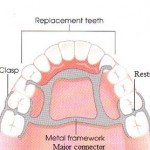Are you a long time denture wearer?
Have you ever wonder what are those components present on your partial dentures?
If yes is the answer to above question, let me explain to you briefly about parts of removable partial denture.
I believe that every denture wearer would like to have a denture which is retentive and stable. Dentures are considered retentive when they are able to resist dislodging forces during function.
Components of removable partial denture
(1)   Major connector –
Major connector serves to unite all other components of partial denture and to allow denture to be rigid.
There are different types of major connectors, and your dental surgeon will choose the best design according to your oral condition. (How many natural teeth left, whether there’s presence of tori, etc)
For example, if you have a large tori (which is a bony protrusion), then most likely an anterior posterior palatal strap will be chosen as a major connector for your partial denture. Anterior posterior palatal strap has a hole in the middle to prevent impingement of tori.
(2)Â Â Â Minor connector-
They serve to connect other components (as mentioned below) to the major connector.
(3)Â Â Â Rest-
Rest is a component of removable partial denture which rests on a prepared tooth surface.
Rests serve to direct all kind of forces along the tooth and to allow denture to stay on its place. They also contribute to your denture stability and retention. Preparation of rest seats involve minimal removal of tooth structure (1-1.5mm) so no anesthesia is needed for this procedure.
(4)Â Â Â Clasps-
Clasps are metal components which emerge out from denture and encircle your tooth. Â Clasps come in various designs and are placed into undercut areas. (present on tooth and determined by the process of surveying) This allows denture to resist dislodging forces in vertical direction. Some people might prefer having clasp free denture. Â Flexible denture is a good example of clasp free denture. Click here to read more about flexible dentures.
http://www.intelligentdental.com/2011/08/23/questions-and-answers-flexible-dentures/
 (5)   Denture base –
They cover the residual ridge (region of missing teeth) and serve as base to support the denture teeth. Â They can be made of acrylic resin (pink) or metal (chrome cobalt). Acrylic resin denture base is cheaper and esthetically superior than metal denture base but they have lower strength and thermal conductivity. In other words, acrylic denture will look nicer but you will be able to feel the temperature of your food /drink better with metal based denture.
(6)   Denture teeth –
They serve to replace missing teeth and they can be made of acrylic or porcelain.
Acrylic denture teeth are more compatible with acrylic denture base as they are made of same material. Pigments are added into it to resemble natural tooth color. Porcelain denture teeth are made of the same porcelain material we used to construct dental crowns and bridges. One of the disadvantages of using porcelain denture teeth is they tend to create a clicking sound when they come into contact.
